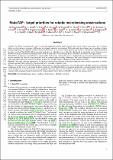Files in this item
RoboTAP : target priorities for robotic microlensing observations
Item metadata
| dc.contributor.author | Hundertmark, M. | |
| dc.contributor.author | Street, R. A. | |
| dc.contributor.author | Tsapras, Y. | |
| dc.contributor.author | Bachelet, E. | |
| dc.contributor.author | Dominik, M. | |
| dc.contributor.author | Horne, K. | |
| dc.contributor.author | Bozza, V. | |
| dc.contributor.author | Bramich, D. M. | |
| dc.contributor.author | Cassan, A. | |
| dc.contributor.author | D'Ago, G. | |
| dc.contributor.author | Jaimes, R. Figuera | |
| dc.contributor.author | Kains, N. | |
| dc.contributor.author | Ranc, C. | |
| dc.contributor.author | Schmidt, R. W. | |
| dc.contributor.author | Snodgrass, C. | |
| dc.contributor.author | Wambsganss, J. | |
| dc.contributor.author | Steele, I. A. | |
| dc.contributor.author | Mao, S. | |
| dc.contributor.author | Ment, K. | |
| dc.contributor.author | Menzies, J. | |
| dc.contributor.author | Li, Z. | |
| dc.contributor.author | Cross, S. | |
| dc.contributor.author | Maoz, D. | |
| dc.contributor.author | Shvartzvald, Y. | |
| dc.date.accessioned | 2017-10-20T14:30:15Z | |
| dc.date.available | 2017-10-20T14:30:15Z | |
| dc.date.issued | 2018-01-05 | |
| dc.identifier | 251290448 | |
| dc.identifier | de045188-5b80-4e61-ad82-d9bf70eda57e | |
| dc.identifier | 85040311060 | |
| dc.identifier | 000419994600002 | |
| dc.identifier.citation | Hundertmark , M , Street , R A , Tsapras , Y , Bachelet , E , Dominik , M , Horne , K , Bozza , V , Bramich , D M , Cassan , A , D'Ago , G , Jaimes , R F , Kains , N , Ranc , C , Schmidt , R W , Snodgrass , C , Wambsganss , J , Steele , I A , Mao , S , Ment , K , Menzies , J , Li , Z , Cross , S , Maoz , D & Shvartzvald , Y 2018 , ' RoboTAP : target priorities for robotic microlensing observations ' , Astronomy & Astrophysics , vol. 609 , A55 . https://doi.org/10.1051/0004-6361/201730692 | en |
| dc.identifier.issn | 0004-6361 | |
| dc.identifier.other | ArXiv: http://arxiv.org/abs/1710.00523v1 | |
| dc.identifier.other | ORCID: /0000-0002-3202-0343/work/75996770 | |
| dc.identifier.uri | https://hdl.handle.net/10023/11892 | |
| dc.description | K.H. acknowledges support from STFC grant ST/M001296/1. | en |
| dc.description.abstract | Context. The ability to automatically select scientifically-important transient events from an alert stream of many such events, and to conduct follow-up observations in response, will become increasingly important in astronomy. With wide-angle time domain surveys pushing to fainter limiting magnitudes, the capability to follow-up on transient alerts far exceeds our follow-up telescope resources, and effective target prioritization becomes essential. The RoboNet-II microlensing program is a pathfinder project which has developed an automated target selection process (RoboTAP) for gravitational microlensing events which are observed in real-time using the Las Cumbres Observatory telescope network. Aims. Follow-up telescopes typically have a much smaller field-of-view compared to surveys, therefore the most promising microlens- ing events must be automatically selected at any given time from an annual sample exceeding 2000 events. The main challenge is to select between events with a high planet detection sensitivity, aiming at the detection of many planets and characterizing planetary anomalies. Methods. Our target selection algorithm is a hybrid system based on estimates of the planet detection zones around a microlens. It follows automatic anomaly alerts and respects the expected survey coverage of specific events. Results. We introduce the RoboTAP algorithm, whose purpose is to select and prioritize microlensing events with high sensitivity to planetary companions. In this work, we determine the planet sensitivity of the RoboNet follow-up program and provide a working example of how a broker can be designed for a real-life transient science program conducting follow-up observations in response to alerts, exploring the issues that will confront similar programs being developed for the Large Synoptic Survey Telescope (LSST) and other time domain surveys. | |
| dc.format.extent | 13 | |
| dc.format.extent | 1991348 | |
| dc.language.iso | eng | |
| dc.relation.ispartof | Astronomy & Astrophysics | en |
| dc.subject | Gravitational lensing: micro | en |
| dc.subject | Methods: observational | en |
| dc.subject | Methods: statistical | en |
| dc.subject | QB Astronomy | en |
| dc.subject | QC Physics | en |
| dc.subject | NDAS | en |
| dc.subject.lcc | QB | en |
| dc.subject.lcc | QC | en |
| dc.title | RoboTAP : target priorities for robotic microlensing observations | en |
| dc.type | Journal article | en |
| dc.contributor.sponsor | Science & Technology Facilities Council | en |
| dc.contributor.institution | University of St Andrews. School of Physics and Astronomy | en |
| dc.contributor.institution | University of St Andrews. St Andrews Centre for Exoplanet Science | en |
| dc.identifier.doi | https://doi.org/10.1051/0004-6361/201730692 | |
| dc.description.status | Peer reviewed | en |
| dc.identifier.grantnumber | ST/M001296/1 | en |
This item appears in the following Collection(s)
Items in the St Andrews Research Repository are protected by copyright, with all rights reserved, unless otherwise indicated.

